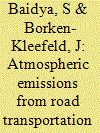| Srl | Item |
| 1 |
ID:
091526


|
|
|
|
|
| Publication |
2009.
|
| Summary/Abstract |
India has become one of the biggest emitters of atmospheric pollutants from the road transportation sector globally. Here we present an up-to-date inventory of the exhaust emissions of ten species. This inventory has been calculated bottom-up from the vehicle mileage, differentiating by seven vehicle categories, four age/technology layers and three fuel types each, for the seven biggest cities as well as for the whole nation. The age composition of the rolling fleet has been carefully modelled, deducting about one quarter of vehicles still registered but actually out-of-service. The vehicle mileage is calibrated to the national fuel consumption which is essential to limit uncertainties. Sensitivity analyses reveal the primary impact of the emission factors and the secondary influence of vehicle mileage and stock composition on total emissions. Emission estimates since 1980 are reviewed and qualified. A more comprehensive inspection and maintenance is essential to limit pollutant emissions; this must properly include commercial vehicles. They are also the most important vehicle category to address when fuel consumption and CO2 emissions shall be contained.
|
|
|
|
|
|
|
|
|
|
|
|
|
|
|
|
| 2 |
ID:
091527


|
|
|
|
|
| Publication |
2009.
|
| Summary/Abstract |
In response to threats posed to the future supply of energy and to the environment, the G8 leaders, in Gleneagles, UK in 2005, agreed to an initiative called the Gleneagles Plan of Action (GPOA) which addresses climate change, clean energy and sustainable development. In the GPOA, G8 leaders pledged to encourage the development of cleaner, more efficient and lower-emitting vehicles, and to promote their deployment by, among other means, asking the IEA to review existing standards and codes for vehicle efficiency and to identify best practices.
In order to properly response to the above-mentioned requests from G8 leaders, the IEA has launched, among other activities, study on policies for "transforming the way we use energy" focusing on end-use efficiency including the one in transport sector and made a comprehensive response to the GPOA at the 2008 G8 Summit Meeting in Japan with 25 recommendations on energy efficiency. Regarding these recommendations, the G8 leaders have proclaimed, in the G8 Hokkaido Toyako Summit Leaders Declaration, that they would maximize implementation of the IEA's 25 recommendations.
|
|
|
|
|
|
|
|
|
|
|
|
|
|
|
|
| 3 |
ID:
149855


|
|
|
|
|
| Summary/Abstract |
The benefit-cost analysis of standards to reduce vehicle greenhouse gas emissions and improve fuel economy by the U.S. Environmental Protection Agency (EPA) and the Department of Transportation (DOT) displays large net benefits from fuel savings for new vehicle buyers. This finding points to an energy efficiency gap: the energy-saving technology provided in private markets appears not to include all the technologies that produce net private benefits. The gap exists if the costs of energy-saving technologies are lower than the present value of fuel reductions, and “hidden costs” – undesirable aspects of the new technologies – do not exceed the net financial benefits. This study examines the existence of hidden costs in energy-saving technologies through a content analysis of auto reviews of model-year 2014 vehicles.
|
|
|
|
|
|
|
|
|
|
|
|
|
|
|
|